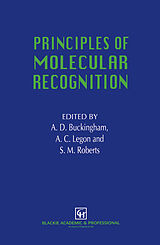Principles of Molecular Recognition
Einband:
Fester Einband
EAN:
9780751401257
Untertitel:
Englisch
Genre:
Chemie
Herausgeber:
Springer Netherlands
Auflage:
1993
Anzahl Seiten:
220
Erscheinungsdatum:
30.09.1993
ISBN:
0751401250
The importance of molecular recognition in chemistry and biology is reflected in a recent upsurge in relevant research, promoted in particular by high-profile initiatives in this area in Europe, the USA and Japan. Although molecular recognition is necessarily microscopic in origin, its consequences are de facto macroscopic. Accordingly, a text that starts with intermolecular interactions between simple molecules and builds to a discussion of molecular recognition involving larger scale systems is timely. This book was planned with such a development in mind. The book begins with an elementary but rigorous account of the various types of forces between molecules. Chapter 2 is concerned with the hydrogen bond between pairs of simple molecules in the gas phase, with particular reference to the preferred relative orientation of the pair and the ease with which this can be distorted. This microscopic view continues in chapter 3 wherein the nature of interactions between solute molecules and solvents or between two or more solutes is examined from the experimental standpoint, with various types of spectroscopy providing the probe of the nature of the interactions. Molecular recognition is central to the catalysis of chemical reactions, especially when bonds are to be broken and formed under the severe con straint that a specific configuration is to result, as in the production of enan tiotopically pure compounds. This important topic is considered in chapter 4.
Inhalt
1 Intermolecular forces.- 1.1 Introduction.- 1.2 The BornOppenheimer approximation.- 1.3 Molecules and forces.- 1.4 The hydrophobic effect.- 1.5 Classification of intermolecular forces.- 1.6 Vibrational contributions to intermolecular forces.- 1.7 Magnitudes of contributions to the interaction energy.- 1.8 Forces between macroscopic bodies.- 1.9 The effect of a medium.- 1.10 The hydrogen bond.- References.- 2 Molecular recognition involving small gas-phase molecules.- 2.1 Introduction.- 2.2 How to determine the angular geometry and strength of intermolecular binding for an isolated dimer.- 2.3 Empirical observations about angular geometries in the series B ... HX.- 2.4 An electrostatic model for the hydrogen bond interaction: the Buckingham Fowler model.- 2.5 The electrostatic model and non-bonding electron pairs.- 2.6 A point-charge representation of non-bonding electron pairs.- 2.7 Isomerism in weakly bound dimers: incipient molecular recognition.- 2.8 Dimers with two interaction sites.- 2.9 Consequences of the rules for angular geometries in the solid state.- References.- 3 Spectroscopic studies of solvents and solvation.- 3.1 Introduction.- 3.1.1 History.- 3.2 Background.- 3.3 Ultraviolet spectroscopy.- 3.4 ESR spectroscopy.- 3.5 Nuclear magnetic resonance studies.- 3.6 Vibrational chromophoric probes.- 3.7 Near infrared studies.- 3.8 Use of results from vibrational spectroscopy to interpret magnetic resonance data.- 3.9 Solvation in biological systems.- References.- 4 Origins of enantioselectivity in catalytic asymmetric synthesis.- 4.1 Introduction.- 4.2 Homogeneous hydrogenation with rhodium complexes.- 4.3 Hydrogenation with ruthenium complexes.- 4.4 Carboncarbon bond formation through cross-coupling.- 4.5 Carboncarbon bond formation through allylicalkylation.- References.- 5 Molecular recognition in the catalytic action of metallo-enzymes.- 5.1 Introduction.- 5.2 Methods for simulating reactions in enzymes and solution.- 5.3 Application to the staphylococcal nuclease reaction.- 5.4 Concluding remarks.- Acknowledgements.- References.- 6 Drug discovery.- 6.1 Introduction.- 6.2 Receptors as targets for drug design.- 6.3 Enzymes as targets for drug design.- 6.4 Drug discovery by screening: concluding remarks.- Acknowledgements.- References.- 7 Time scales and fluctuations of protein dynamics: metmyoglobin in aqueous solution.- 7.1 Introduction.- 7.2 Methods.- 7.3 Spatial and temporal fluctuations.- 7.4 Conclusions.- Acknowledgements.- References.

Leider konnten wir für diesen Artikel keine Preise ermitteln ...
billigbuch.ch sucht jetzt für Sie die besten Angebote ...
Die aktuellen Verkaufspreise von 6 Onlineshops werden in Realtime abgefragt.
Sie können das gewünschte Produkt anschliessend direkt beim Anbieter Ihrer Wahl bestellen.
Loading...
Die aktuellen Verkaufspreise von 6 Onlineshops werden in Realtime abgefragt.
Sie können das gewünschte Produkt anschliessend direkt beim Anbieter Ihrer Wahl bestellen.
| # | Onlineshop | Preis CHF | Versand CHF | Total CHF | ||
|---|---|---|---|---|---|---|
| 1 | Seller | 0.00 | 0.00 | 0.00 |
